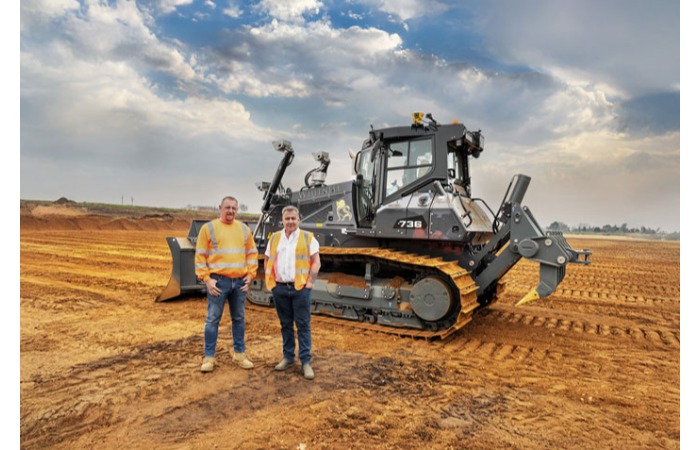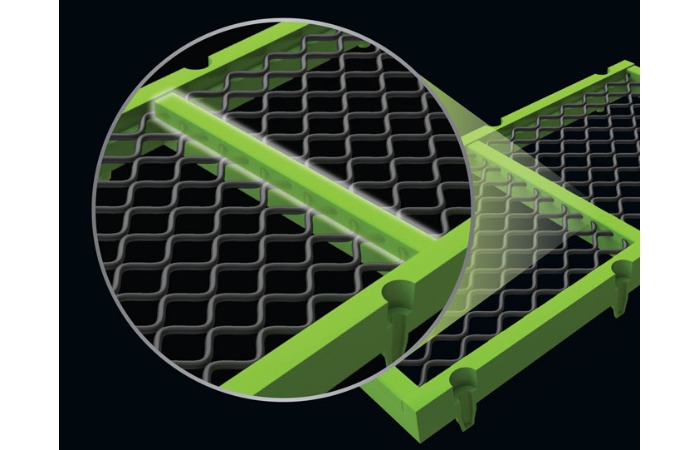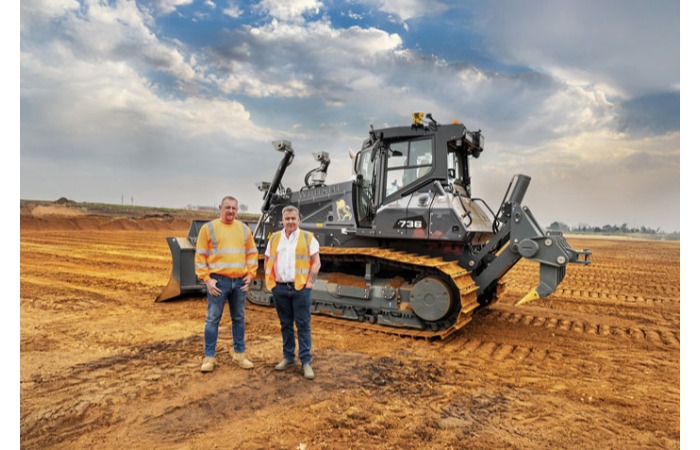Schedule a Call Back
Cummins is developing future low-carbon technologies

Jameson Mendonca, Power Generation Business Leader at Cummins India, highlights how the company is integrating digital monitoring and smart power management into its gensets.
With India’s infrastructure boom, how do you see the demand for advanced power solutions shaping the construction equipment industry in the coming years?
India’s genset market is playing a crucial and multifaceted role in bridging the nation’s power reliability gap—especially amid surging infrastructure development and rapid digital expansion. With rapid urbanisation, infrastructure rollout, digital services growth, and rural electrification, the demand for uninterrupted electricity has grown exponentially. Power requirements are becoming even more critical in remote, semi-urban, or developing areas.
In such environments, gensets become indispensable for infrastructure, manufacturing, and construction sites, where electricity is vital for machinery, lighting, and operations. At such locations, where grid power is unavailable or intermittent, gensets often serve as the primary source of reliable power.
This is where Cummins plays a pivotal role. We offer fit-for-market solutions with tailored power capacities, backed by 24x7 maintenance services and technical support. By enabling timely maintenance, enhancing performance control, and ensuring compliance with environmental standards, our technologies collectively reduce downtime and operational expenses, creating a more dependable and efficient energy solution.
As an alternative power solution provider, Cummins is focused on our Destination Zero strategy, which centres on delivering solutions that meet varied customer needs. We are taking a holistic approach to sustainability across the entire product lifecycle. Our products are continuously built and improvised to fit market requirements - improving fuel economy and reducing emissions through Bridge Technologies. Building on this, our CAQM-compliant products, CPCB IV+ gensets, and the recently launched BESS offering—delivering zero-emission power—are strong steps forward as we progress on our Destination Zero strategy.
Cummins’ new QSK60-G29 generator and turbocharging system promise higher efficiency and uptime. How do these technologies support contractors and equipment owners in construction projects where reliability is non-negotiable?
The QSK60 G29 engine from Cummins powers a cutting-edge 2500 kVA genset, redefining the Construction segment where gensets are relied upon as a primary source of power. Engineered for excellence with the Power of Titanium, this Quantum series genset also delivers unmatched performance at higher altitudes, making it a trusted solution for both the Construction and Data Center markets.
The QSK60 G29 is a 60-litre, 16-cylinder, V-type full authority electronic engine, delivering power ratings from 2000 kVA to 2500 kVA. Equipped with an HE800 Turbocharger with a titanium impeller, it enhances both performance and durability. Designed to meet stringent testing requirements, it ensures top ambient and altitude performance, while its high-power density maximises output even in compact spaces.
With an optimised fuel system and camshaft profiles, the QSK60 G29 ensures precise fuel injection, resulting in improved fuel efficiency. Its reinforced steel pistons and power cylinder components withstand higher temperatures and pressures with ease, ensuring reliability under demanding conditions. Compact in design, it simplifies installation, improves efficiency, and extends service intervals—reducing costs while delivering dependable power.
The modernisation of the Pamban Bridge was a landmark infrastructure project. What were the unique power requirements, and what lessons can be applied to other large-scale construction projects?
Understanding the strategic importance of uninterrupted power for the bridge’s advanced vertical lift system and surveillance infrastructure, Cummins delivered a tailored power solution engineered for reliability. Following an in-depth feasibility study and on-site technical assessment, we installed two high-performance 650 kVA CPCB II compliant gensets, powered by robust 19L Quantum Series engines – ensuring seamless operation even under demanding conditions. Given the mission-critical nature of the application, the dual configuration provided assurance of continuous power delivery during maintenance or in the rare event of generator downtime.
The bridge’s lift system itself is a mechanical symphony. Two massive towers house dual motors, each with separate gearboxes and wheels. These motors draw power from the gensets at an engine speed of 1,000 to 1,500 RPM, which is reduced to 750 RPM, and then precisely slowed to 5 RPM at the wheel level. While only one side operates at a time, both towers engage simultaneously during a lift. The lift cycle follows four speed stages—25 per cent, 50 per cent, 75 per cent, and 100 per cent with a full lift completed in approximately 5 minutes.
Installation was meticulous. About 10 to 12 hours of rigorous factory testing were followed by site-level trials. The Cummins team pre-mapped engineering resources, managed alternator crating and acquisition, aligned vibration control systems, and customised site-specific integration. Despite complex logistics and environmental constraints, the units were delivered and installed on time. The project was further reinforced by Cummins’ dedicated aftermarket support, with a service team present on-site and a single point of contact for seamless communication and escalation.
The marine environment posed formidable challenges—salt-laden air, aggressive winds, and corrosive moisture required exceptional adaptability. Cummins gensets, known for durability in high-load operations, fuel efficiency, and low emissions, were fitted with advanced Cummins PowerCommand control systems. These enabled real-time load monitoring, diagnostics, and smooth synchronisation with bridge operations.
From overcoming marine corrosion and structural limitations to integrating high-precision mechanical systems, Cummins’ involvement was holistic. Every bolt, every test, and every step taken under blazing sun and salty winds reflected a commitment that transcended machinery. The Power of One at Cummins also came through in the resilience of the team—walking kilometers daily due to restricted vehicle access—ensuring the project’s completion under the toughest conditions, a spirit that applies across all projects we undertake.
Cummins remains at the forefront of mission-critical, iconic projects now and in the future. With fit-for-market products designed to address diverse customer needs, supported by best-in-class R&D facilities, a wide portfolio ranging from 7.5 kVA to 3750 kVA, future-ready technology, and emission-compliant gensets, we are equipped to meet varied site requirements with efficiency and reliability - even at challenging altitudes and temperature.
Construction companies are increasingly adopting IoT and telematics in equipment. How is Cummins integrating digital monitoring and smart power management into gensets to complement this shift?
Our CPCB IV+ gensets are equipped with advanced after-treatment systems designed to improve fuel efficiency while ensuring compliance with stringent emission norms. Additionally, we have implemented a closed-loop system with real-time remote monitoring capabilities. This system continuously tracks the genset’s operating performance and emission compliance, triggering alarms for immediate corrective action in case of deviations. Customers also receive SMS and email alerts, enabling timely responses that minimise downtime, maintain peak performance, and enhance the overall reliability and longevity of the equipment.
The integration of advanced engine technologies enhances system durability, performance, fuel economy, and overall reliability, while empowering customers to actively contribute to environmental sustainability. Equipped with IoT sensors and telematics, these gensets offer real-time monitoring, performance analytics, and remote diagnostics - —leading to optimised fuel use, reduced downtime, and predictive maintenance.
With emission norms tightening for construction equipment, how is Cummins aligning its “Destination Zero” strategy to provide cleaner, lower-carbon solutions for this sector?
As part of our Destination Zero initiative, Cummins is actively developing technologies that will significantly reduce carbon emissions in the future, including bridge technology products that enable a smoother transition toward next-generation solutions. We are well on our way to achieving several of our environmental goals to reduce site and community greenhouse gas (GHG) emissions, volatile organic compounds (VOCs), water usage, and waste, and these commitments remain firmly intact.
To further strengthen our impact, we are making meaningful changes to our sustainability metrics. These include shifting our focus on material circularity from individual parts to new products and integrating our facilities and waste operations goals to accelerate progress toward achieving zero waste growth by 2030.
We remain relentless in pursuing our 2030 environmental sustainability goals and our commitment to a net-zero future. Guided by our mission of making people’s lives better by powering a more prosperous world, we are committed to enabling customer success, growing our business responsibly, creating opportunities for our people, positively impacting communities, and protecting the planet for generations to come.
Our global commitment to decarbonisation, combined with a strong and enviable India legacy, places us in a unique position to lead India’s transition to zero emissions by 2070. With a focus on action, we continue advancing our journey to power a cleaner and greener India.
The genset industry is poised for growth and innovation, particularly through hybrid power solutions, off-grid applications, and emerging markets. These developments present opportunities to enhance energy efficiency and reliability while addressing global energy challenges. At Cummins, our Destination Zero strategy is built on delivering solutions tailored to diverse customer needs while adopting a holistic sustainability approach across the entire product lifecycle—from cradle to grave.
Our products are continually enhanced to meet evolving market requirements, with a focus on improving fuel economy and reducing emissions through Bridge Technologies. Building on this foundation, our CAQM-compliant products, CPCB IV+ gensets, and the recent BESS offering—delivering zero-emission power—represent strong steps forward as we progress on our Destination Zero journey.
How does Cummins work with OEMs, rental players, and contractors in the construction equipment ecosystem to ensure reliability and timely service support?
We have a strong channel presence across India, supported by 3 GOEM partners and 140+ highly skilled sales dealers. Our extensive network of 480+ service touchpoints ensure customers experience minimal to no downtime, backed by a 4-hour service response guarantee and a 2-hour response time for critical applications.
What next-generation technologies or solutions can the construction equipment industry expect from Cummins in India over the next 3–5 years?
As an alternative power solutions leader, Cummins is driving its Destination Zero strategy, focused on delivering solutions that meet the varied needs of our customers. Our approach is holistic, emphasising sustainability across the entire product lifecycle. At the same time, our products are continuously developed and refined to fit evolving market requirements, with a focus on improving fuel economy and reducing emissions at every possible level through Bridge Technologies. Taking this forward, our CAQM-compliant products, CPCB IV+ gensets, and the latest BESS offering—designed to deliver zero-emission power—mark significant milestones in advancing our Destination Zero strategy.


Subscribe Now
Subscribe to our Newsletter & Stay updated
RECENT POSTS
Popular Tags
Folliow us
Related Stories
Sinoboom CEO Addresses India’s MEWP Industry
Susan Xu, Owner and Group CEO of Sinoboom, recently addressed members of the Aerial Platform Association of India during a celebratory dinner hel...
MAJOR Showcases Screen Media Technology at CONEXPO/CON-AGG 2026
MAJOR, a global manufacturer of high-performance wire screen media, will exhibit at CONEXPO/CON-AGG 2026, where it will showcase its screen media s...











